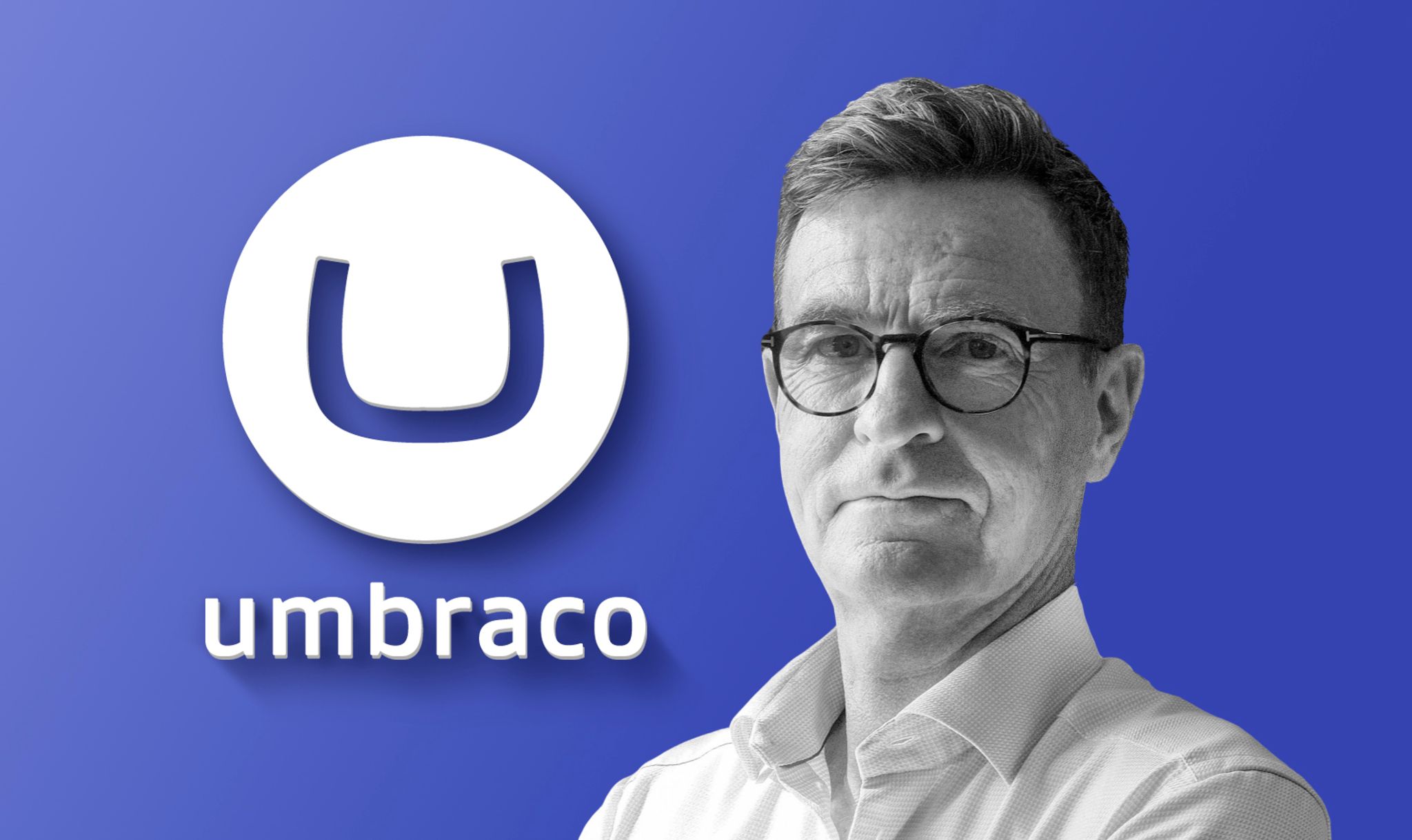The Right Person to Lead: Umbraco Appoints Mats Persson as CEO, Reflecting Growth Ahead

The freshly minted chief executive brings decades of industry experience to his new role, reflecting the company’s rapid growth, international expansion, and increased enterprise adoption.
What does it mean to be “The Friendly CMS”?
I don’t ask to be coy or sarcastic. This tagline has reached legendary status at Umbraco, permeating its messaging for years. There’s clearly something sticky about it.
In the most reductive sense, one might conclude it’s a content management system that’s easy to use. Or, as the mantle suggests, “user-friendly.”
But that’s too one-dimensional. Lots of platforms could claim user-friendliness. That’s why Umbraco has infused this tagline with more gusto, and there’s an origin story that sheds more light on the subject.
According to mythology, “The Friendly CMS” was conceived by one of Umbraco’s community members, Hudson Maul, back in 2006 (almost two decades if we’re keeping score). He included the now-famous moniker in his mockups for a new Umbraco.com website. When asked about it, he reflected: “Everything about Umbraco is friendly. The UX, the community, and the pricing.”
Simple. Elegant. Universally understood. That’s what makes it sticky.
I’ve followed Umbraco for many years – they’ve certainly stood the test of time – and this idea of being friendly goes far beyond the confines of its open source .NET technology. Which, by the way, continues to be a novel arrow in its quiver.
Here’s the deal: being “The Friendly CMS” has as much to do with its global spirit and fiercely passionate community as its products. From what I’ve observed, Umbraco has consistently committed to being a people company first – one that endeavors to democratize its innovation, support its builders, and make a positive impact in our world.
This impact is crystallized in the company’s 2024 Annual Impact Report, published in April. It illustrates a fervent internal and external focus on achieving measurable strides in sustainability while nurturing a culture of diversity and inclusion at a global level. It certainly helps cement the case for being “friendly” in a palpable way.
But as Hudson Maul codified, their CMS is about people, too. It’s engineered with purpose and provides a clean, clear, intuitive experience that still wins hearts and minds.
For all these reasons, finding the right person to lead the next chapter of Umbraco’s story is clearly vital to its future. And it seems that Mats Persson is, indeed, that person.
The timing couldn’t be more apropos. Umbraco has experienced triumphant growth over the last few years. With a stellar reputation, it now counts itself among the top web CMS platforms serving the UK public sector, and among G2’s Top 50 EMEA Companies.
Perhaps more importantly, Umbraco is an open source CMS, competing in a landscape of large proprietary enterprise systems, composable DXPs, and a mele of headless platforms. As it turns out, Umbraco offers solutions that can go toe-to-toe across the market, like its Heartcore Headless CMS and Umbraco Cloud – all connected to a wellspring of open source to provide support, innovation, and more.
As Persson steps into his new role, he faces headwinds in every direction: shrinking IT budgets, shaky economic signals, and shifting buying patterns (to name a few). And of course, there’s the continued challenge of helping buyers see the forest through the composable trees and weed out confusion.
Setting the negative acoustics aside, the evolving preference for open source solutions at an enterprise level could be a real game changer for Umbraco. Being open is, after all, its bread and butter. But the real key here is Umbraco’s partners, who have closed more enterprise opportunities with its products – and Persson has his sights set on the channel to amplify growth.
A fond farewell to the Kim Years
There’s something about a bow tie that exudes class. And Kim Sneum-Madsen, famous for sporting this overlooked fashion accouterment, is a class act all around.
As Umbraco’s previous head of state, Sneum-Madsen embodied the friendliest attributes that have defined the company’s ethos. Since 2016, he has served as Umbraco’s eponymous “Chief Friend Maker” and provided ambassadorial duties to the community at large. In 2019, he took the reins as CEO, navigating Umbraco through the unprecedented challenges of a pandemic and its subsequent digital acceleration – a tumultuous period across the tech frontier. At that time, Umbraco had just 56 employees.
In the years that followed, Sneum-Madsen grew the company substantially, tripling the headcount while focusing on scalable processes and products. This included the development of Umbraco Cloud and regional hosting services situated around the globe.
During his tenure, Sneum-Madsen also facilitated several key acquisitions that strengthened Umbraco’s product offerings and developed a robust partner network. The growth spurt was also fueled by a Westward drift to the larger U.S. market, supported by a beachhead in Charlotte, NC.
Fear not: Kim will remain on Umbraco’s board of directors, lending his continued knowledge to a company that is imprinted with his DNA. “Umbraco has achieved consistent, strong growth over the past two years,” said Martin Henricson, Chairman of the Board at Umbraco and Managing Director at Monterro (an investment firm that acquired a majority stake in Umbraco in 2021. “Kim believes that now is the right time to hand over the baton.”
From ad tech to CMS
Persson will marshal thirty years of leadership experience into his new job as CEO. With a Master’s degree in computer science and a Bachelor’s in economics, he brings a unique combination of technology and financial considerations that can generate value and create sustainable growth for both early-stage and established companies.
Persson comes to Umbraco from Cavai, where he was CEO for just over two years. An award-winning global interactive advertising cloud, Cavai works with agencies, publishers, advertisers, and other platforms across ten markets and three continents. It specializes in conversational ad tech like banners, video, and commerce solutions with a clear focus on privacy.
Persson’s resume includes impressive stints in senior leadership positions at IBM and PWC, but one of his longest tenures was at Adform – an established leader in online advertising media services. As SVP, he helped shepherd a 50% ARR and the expansion from 5 to 18 offices worldwide from 2011 to 2017, a period of accelerated growth, innovation, and rising compliance and privacy considerations in the ad tech field.
Building on the open source advantage
As Umbraco’s new CEO, Persson will undoubtedly blend his extensive experience and leadership with the company’s teams, community, and partners. Based on the company’s recent traction, his roadmap will likely build on Umbraco’s diverse solutions and global expansion – all reinforced by its open-source posture.
“This is a really exciting time to be joining the company,” Persson said in the company’s press release. “Umbraco has steadily grown to 150 people, with its international presence reinforced by a well-established partner network and a global community of highly-engaged open-source software contributors. Over the past thirty years of working in this industry I’ve seen that once a company reaches this size, that’s when it really gains momentum in the market.”
Persson also pointed to the growing adoption of open-source software within the enterprise and public sector as an opportunity for Umbraco – specifically to build on the growth achieved in the past year and increase its international expansion.
“I’ve spent decades working with proprietary software enterprises and start-ups, so I am looking forward to applying my experience within an open source CMS company that allows digital organizations the freedom to build exactly what they need,” he said. “Umbraco is also a truly international company and that’s where I bring particular value, having worked in the UK, US, and Nordics.”
Along with its vigorous open source community, Persson sees Umbraco’s digital agency partner network as a force multiplier for its ambitions, and that leveraging its footprint and ability to deliver local support as decisive attributes.
“Umbraco already has partners and customers throughout the EU, UK, US, Australia and New Zealand, India, Vietnam, and Nepal and I’m looking forward to helping the company to build on that global presence,” he said. “The open-source CMS platform is also highly flexible and scalable, giving customers the freedom to build digital experiences that meet evolving business needs. When we support our partners and help them to grow their business with solutions that solve customers’ problems, increase transactions, and enable transformation, everyone profits.”
Why it matters
In my recent keynote Q&A with Dries Buytaert (the acclaimed founder of Drupal) at the Boye & Company CMS Connect Conference in Montreal, we discussed open source at length. One of the biggest questions on the docket: why industry analysts continue to look past these CMS platforms when surveying the market for their various grids and waves (you know of whom I speak).
There isn’t one answer to this conundrum. Yes, there's an explicit formula based on revenue and other metrics. But the fact is, enterprise software platforms spend big bucks to engage with analysts, thus reinforcing their visibility and, perhaps, their preference.
It’s impossible to eliminate all the biases. We are, after all, only human.
But open source has come a long way, and the dominance of OSS (open source software) platforms like WordPress is simply undeniable. When I last spoke to Mathias Bolt Lesniak of the Open Alliance, we discussed the ripple effect of the Swiss government’s EMBAG legislation – a law that requires public sector entities to provide their apps as OSS. EMBAG was not without controversy, and some of the biggest opponents gumming up the works were proprietary platforms.
This predilection towards OSS is also manifesting in a broader movement across enterprises as more companies begin to reassess the pros of open source – instead of the entrenched cons around stability, scalability, and, of course, security. The fact is, open source tools are being used across tech stacks: Kubernetes, Docker, MySQL, Linux… the list goes on. You can read more about these considerations in my recent article about the EMBAG law and its implications.
Persson has a unique opportunity on his hands. Umbraco is an established and well-respected brand with a solid European footprint. As it looks West, there are opportunities to snare more of the addressable U.S. market – and building a stronger partner network could be key to its success. But if it can harness the market winds as they shift towards open source, there could be bigger fish on the line.
Bringing on a new CEO is also a bold statement to the market, establishing Umbraco's intentions to shake things up. Culling a candidate with a strong background in digital advertising, media, and agency-focused services is a smart move, sending a further signal that Umbraco is focused on enriching its partnerships.
In terms of his leadership style, Umbraco’s press release highlighted Persson's proclivity towards trusting and empowering his teams, which should gel nicely with Umbraco’s existing culture.
“Umbraco is branded as ‘The Friendly CMS,’” he said. “Those core values of making things easy for users, and taking care of its partners, open-source community, and people, are demonstrated at every level of the organization.”
That's what makes Umbraco so friendly: the right people.
And of course, the right person to help lead the way.

CMS Kickoff 2025
January 14-15, 2025 – Tampa Bay Area, Florida
Join us next January in the Tampa Bay area of Florida for the third annual CMS Kickoff – the industry's premier global event. Similar to a traditional kickoff, we reflect on recent trends and share stories from the frontlines. Additionally, we will delve into the current happenings and shed light on the future. Prepare for an unparalleled in-person CMS conference experience that will equip you to move things forward. This is an exclusive event – space is limited, so secure your tickets today.
